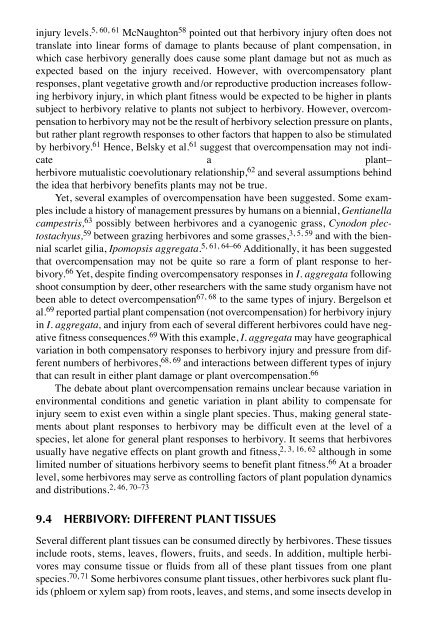Biotic Stress and Yield Loss
Biotic Stress and Yield Loss
Biotic Stress and Yield Loss
- No tags were found...
You also want an ePaper? Increase the reach of your titles
YUMPU automatically turns print PDFs into web optimized ePapers that Google loves.
injury levels. 5, 60, 61 McNaughton 58 pointed out that herbivory injury often does nottranslate into linear forms of damage to plants because of plant compensation, inwhich case herbivory generally does cause some plant damage but not as much asexpected based on the injury received. However, with overcompensatory plantresponses, plant vegetative growth <strong>and</strong>/or reproductive production increases followingherbivory injury, in which plant fitness would be expected to be higher in plantssubject to herbivory relative to plants not subject to herbivory. However, overcompensationto herbivory may not be the result of herbivory selection pressure on plants,but rather plant regrowth responses to other factors that happen to also be stimulatedby herbivory. 61 Hence, Belsky et al. 61 suggest that overcompensation may not indicatea plant–herbivore mutualistic coevolutionary relationship, 62 <strong>and</strong> several assumptions behindthe idea that herbivory benefits plants may not be true.Yet, several examples of overcompensation have been suggested. Some examplesinclude a history of management pressures by humans on a biennial, Gentianellacampestris, 63 possibly between herbivores <strong>and</strong> a cyanogenic grass, Cynodon plectostachyus,59 between grazing herbivores <strong>and</strong> some grasses, 3, 5, 59 <strong>and</strong> with the biennialscarlet gilia, Ipomopsis aggregata. 5, 61, 64–66 Additionally, it has been suggestedthat overcompensation may not be quite so rare a form of plant response to herbivory.66 Yet, despite finding overcompensatory responses in I. aggregata followingshoot consumption by deer, other researchers with the same study organism have notbeen able to detect overcompensation 67, 68 to the same types of injury. Bergelson etal. 69 reported partial plant compensation (not overcompensation) for herbivory injuryin I. aggregata, <strong>and</strong> injury from each of several different herbivores could have negativefitness consequences. 69 With this example, I. aggregata may have geographicalvariation in both compensatory responses to herbivory injury <strong>and</strong> pressure from differentnumbers of herbivores, 68, 69 <strong>and</strong> interactions between different types of injurythat can result in either plant damage or plant overcompensation. 66The debate about plant overcompensation remains unclear because variation inenvironmental conditions <strong>and</strong> genetic variation in plant ability to compensate forinjury seem to exist even within a single plant species. Thus, making general statementsabout plant responses to herbivory may be difficult even at the level of aspecies, let alone for general plant responses to herbivory. It seems that herbivoresusually have negative effects on plant growth <strong>and</strong> fitness, 2, 3, 16, 62 although in somelimited number of situations herbivory seems to benefit plant fitness. 66 At a broaderlevel, some herbivores may serve as controlling factors of plant population dynamics<strong>and</strong> distributions.2, 46, 70–739.4 HERBIVORY: DIFFERENT PLANT TISSUESSeveral different plant tissues can be consumed directly by herbivores. These tissuesinclude roots, stems, leaves, flowers, fruits, <strong>and</strong> seeds. In addition, multiple herbivoresmay consume tissue or fluids from all of these plant tissues from one plantspecies. 70, 71 Some herbivores consume plant tissues, other herbivores suck plant fluids(phloem or xylem sap) from roots, leaves, <strong>and</strong> stems, <strong>and</strong> some insects develop in

















